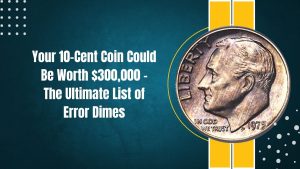Britons are being urged to rummage through their wallets, piggy banks, and even forgotten drawers for a rare £1 coin that might be worth far more than its face value. A unique minting error involving mismatched dates has made certain £1 coins highly valuable to collectors, with some fetching prices as high as £2,500.
Contents
What Makes These £1 Coins Special?
The value of these coins lies in a rare dual-dating error, where two different dates appear on the same coin. One date is prominently displayed on the front side, next to the monarch’s portrait, while the other is subtly etched into the rim in micro-lettering.
Specifically, some £1 coins from 2016 feature the year 2017 engraved on their rim. This inconsistency has turned them into collector’s items, with one such coin recently being sold for an impressive £2,500 to a collector in Spain.
How to Identify the Rare £1 Coin
If you’re wondering whether you own one of these valuable coins, here’s a step-by-step guide to help you identify them:
Step 1: Check for Two Dates
- Look for the year 2016 prominently displayed next to the portrait of Queen Elizabeth II on the front of the coin.
Step 2: Inspect the Rim
- Use a magnifying glass or a microscope to closely examine the rim. The second date, 2017, will be etched in tiny lettering.
Step 3: Confirm the Mismatch
- The hallmark of this rare coin is the discrepancy between the two dates—2016 on the face and 2017 on the rim.
Coins matching these criteria are extremely rare, and those discovered so far have fetched substantial sums, with one notable example being sold for £2,500 to an enthusiastic collector.
Key Features of the Rare £1 Coin
The table below outlines the distinguishing features of this valuable coin:
| Feature | Description |
|---|---|
| Coin Shape | 12-sided design introduced in 2016 to improve security |
| Monarch’s Side | Displays Queen Elizabeth II’s portrait with the year 2016 |
| Rim Micro-Lettering | The year 2017 etched on the edge, visible only under magnification |
| Tools Needed | Magnifying glass or microscope required to identify the error |
Why Are These Coins So Valuable?
The extraordinary rarity and uniqueness of these £1 coins make them highly prized among collectors. Normally, coins are minted with meticulous precision, ensuring that all dates and details are accurate. However, this minting error has created a small batch of coins with mismatched dates, making them a rare historical artifact.
Collectors are particularly drawn to errors like this because they reflect a rare mistake in the otherwise rigorous minting process. The combination of scarcity and historical significance drives up the value, with collectors willing to pay a premium for coins in good condition.
Expert Tips on Identifying Rare Coins
Experts like The Coin Collector UK have weighed in on the subject. In a TikTok video, a representative demonstrated how to identify these error coins. According to the expert, while the 2016 date is easy to spot, the 2017 micro-lettering on the rim requires a magnifying tool.
“This is an exceptionally rare error, and if you’re lucky enough to own one, it could be worth a small fortune,” the expert explained. The rarity of these coins means only a handful have surfaced, with one recently fetching £2,500.
How to Check Your Coins for Errors
If you suspect you might have one of these valuable £1 coins, here’s how you can confirm:
- Gather Your £1 Coins: Collect all 12-sided £1 coins minted from 2016 onwards.
- Check the Date Next to the Monarch: Look for the year 2016 next to Queen Elizabeth II’s portrait.
- Examine the Rim Closely: Use a magnifying glass or microscope to inspect the rim for the year 2017 in micro-lettering.
- Verify the Mismatch: The critical feature is the combination of 2016 on the face and 2017 on the rim.
The Historical Context Behind the Minting Error
The 12-sided £1 coin was introduced in 2016 as part of efforts to combat counterfeiting. These new coins featured enhanced security measures, including the unique 12-sided design and micro-lettering on the rim. The dual-dating error likely occurred during the transition from the old round £1 coins to the newer design, adding to its significance as a modern minting anomaly.
Why You Should Inspect Your Change
Although the odds of finding one of these rare coins are slim, it’s still worth checking your spare change. These coins could potentially be hiding in your wallet or among your loose change, unnoticed due to their unassuming appearance.
Collectors remain actively on the hunt for such coins, meaning there’s still a chance you could stumble upon one and turn it into a profitable find. The rarity of these coins, combined with their historical significance, makes them one of the most sought-after modern collectibles.
FAQs
Why are these £1 coins considered rare?
These coins are rare due to a minting error that resulted in two different dates—2016 and 2017—being stamped on the same coin.
How much can these coins sell for?
One such coin recently sold for £2,500, and similar coins in good condition are expected to fetch similar prices.
What tools do I need to identify the error?
A magnifying glass or microscope is essential to spot the micro-lettering with the year 2017 on the coin’s rim.







